International Court Case: Settlement Strategy for MBA 517 Dispute
VerifiedAdded on 2023/06/04
|6
|979
|63
Case Study
AI Summary
This case study analyzes a dispute between a Fortune 100 company in the U.S. and a company in a third-world country, following an International Court ruling in favor of the U.S. company. The third-world country's government is dissatisfied, leading to the suspension of a $1 billion contract. The assignment requires developing a settlement strategy to resolve the dispute without damaging the company's image while allowing the third-world country to save face. The analysis explores options such as monetary compensation, technological transfer, and training programs. The report emphasizes the importance of negotiation, political considerations, and the limitations of the International Court of Justice. The recommended strategy involves providing technology, training, and potentially offering positions to government officials to achieve a balanced settlement. References include strategic planning and dispute resolution resources.
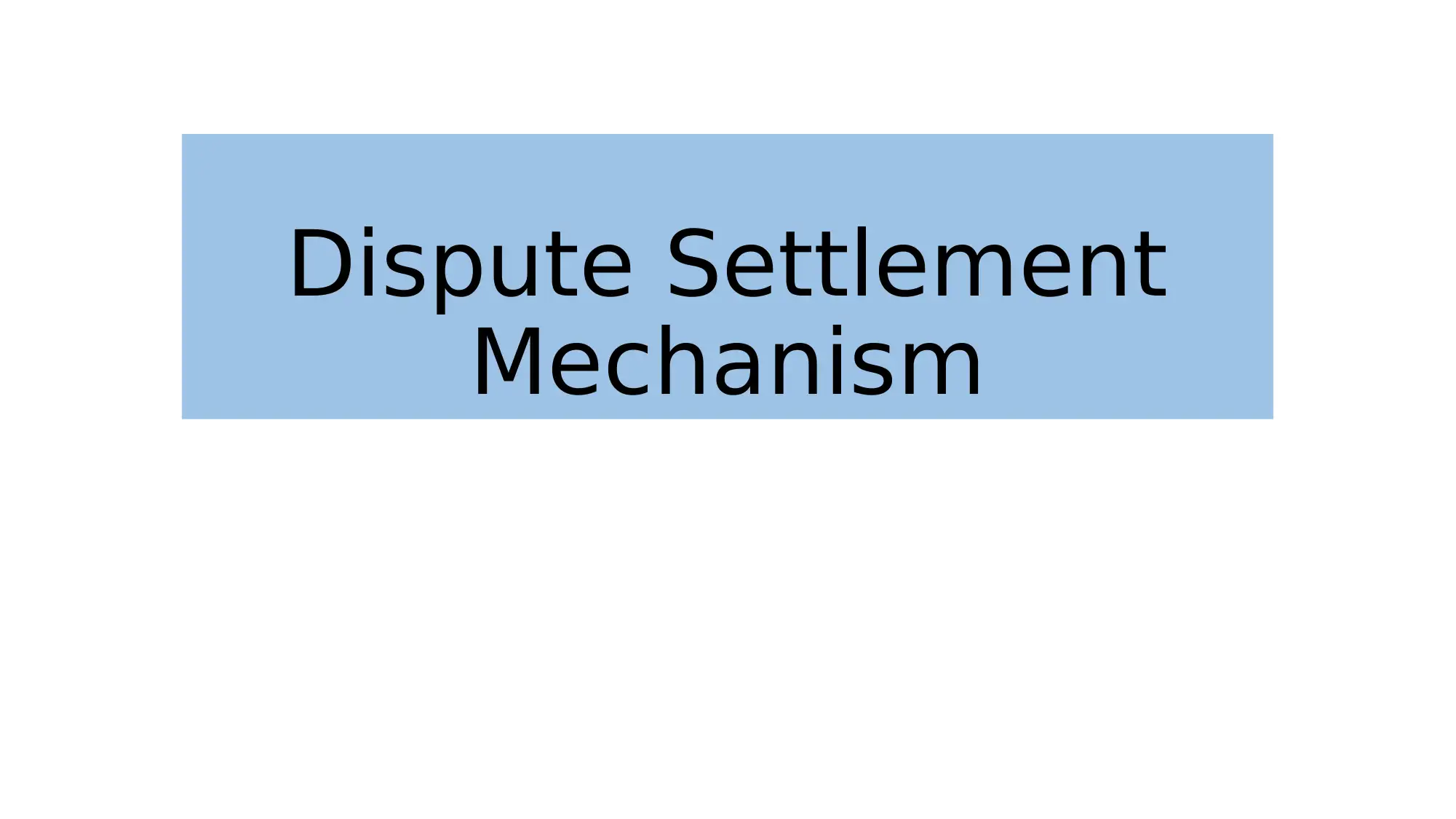
Dispute Settlement
Mechanism
Mechanism
Paraphrase This Document
Need a fresh take? Get an instant paraphrase of this document with our AI Paraphraser
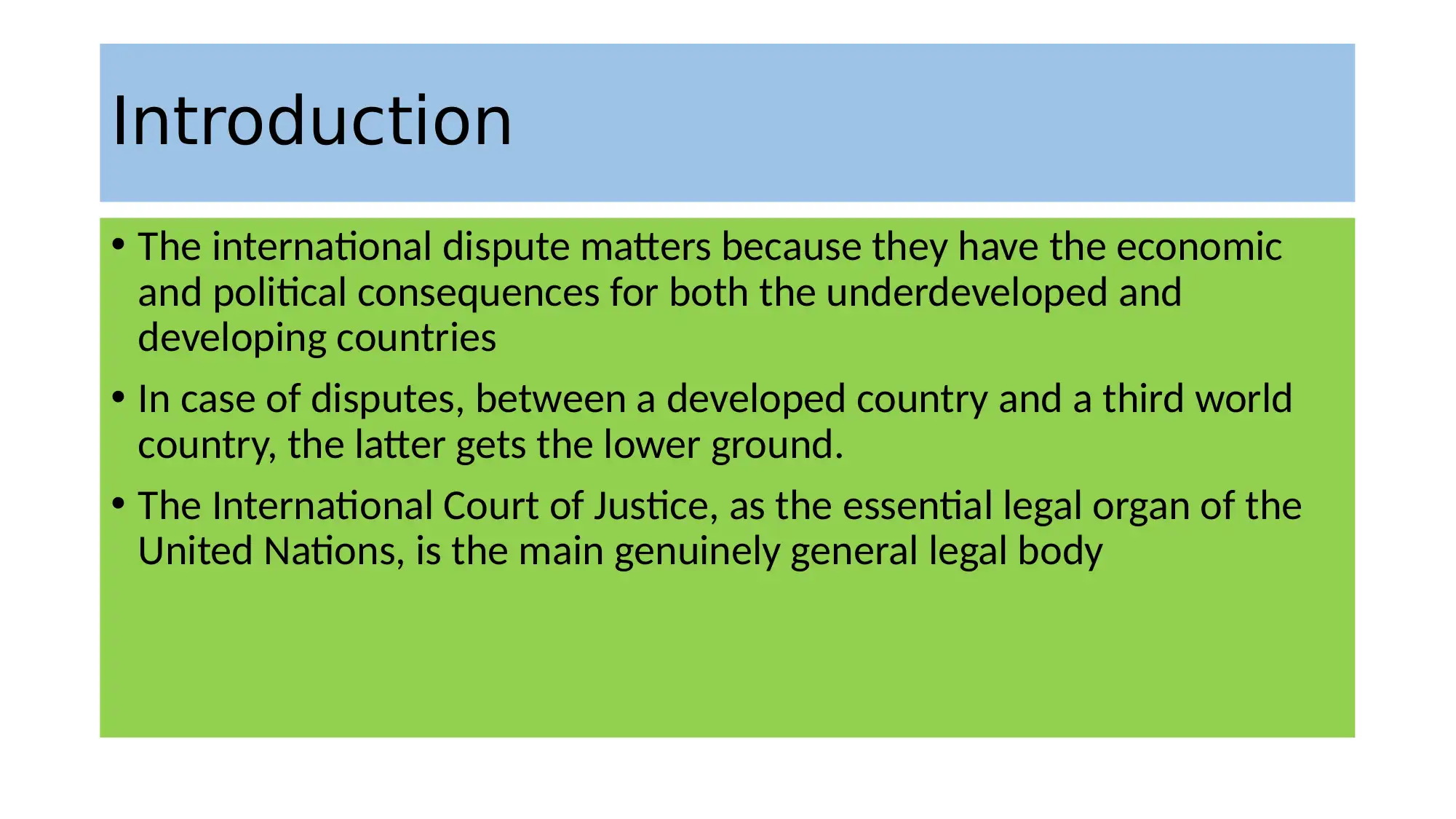
Introduction
• The international dispute matters because they have the economic
and political consequences for both the underdeveloped and
developing countries
• In case of disputes, between a developed country and a third world
country, the latter gets the lower ground.
• The International Court of Justice, as the essential legal organ of the
United Nations, is the main genuinely general legal body
• The international dispute matters because they have the economic
and political consequences for both the underdeveloped and
developing countries
• In case of disputes, between a developed country and a third world
country, the latter gets the lower ground.
• The International Court of Justice, as the essential legal organ of the
United Nations, is the main genuinely general legal body
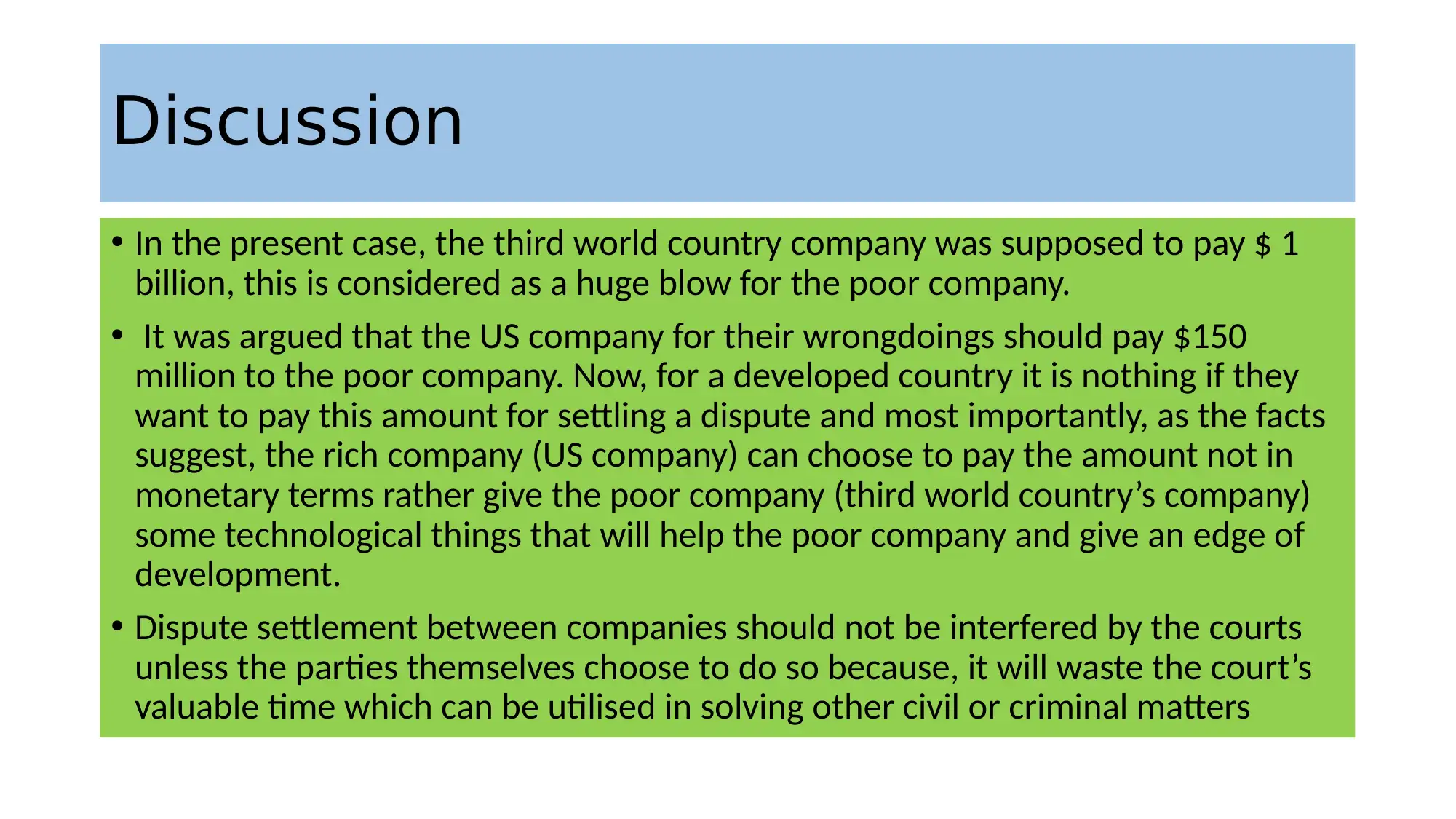
Discussion
• In the present case, the third world country company was supposed to pay $ 1
billion, this is considered as a huge blow for the poor company.
• It was argued that the US company for their wrongdoings should pay $150
million to the poor company. Now, for a developed country it is nothing if they
want to pay this amount for settling a dispute and most importantly, as the facts
suggest, the rich company (US company) can choose to pay the amount not in
monetary terms rather give the poor company (third world country’s company)
some technological things that will help the poor company and give an edge of
development.
• Dispute settlement between companies should not be interfered by the courts
unless the parties themselves choose to do so because, it will waste the court’s
valuable time which can be utilised in solving other civil or criminal matters
• In the present case, the third world country company was supposed to pay $ 1
billion, this is considered as a huge blow for the poor company.
• It was argued that the US company for their wrongdoings should pay $150
million to the poor company. Now, for a developed country it is nothing if they
want to pay this amount for settling a dispute and most importantly, as the facts
suggest, the rich company (US company) can choose to pay the amount not in
monetary terms rather give the poor company (third world country’s company)
some technological things that will help the poor company and give an edge of
development.
• Dispute settlement between companies should not be interfered by the courts
unless the parties themselves choose to do so because, it will waste the court’s
valuable time which can be utilised in solving other civil or criminal matters
⊘ This is a preview!⊘
Do you want full access?
Subscribe today to unlock all pages.

Trusted by 1+ million students worldwide
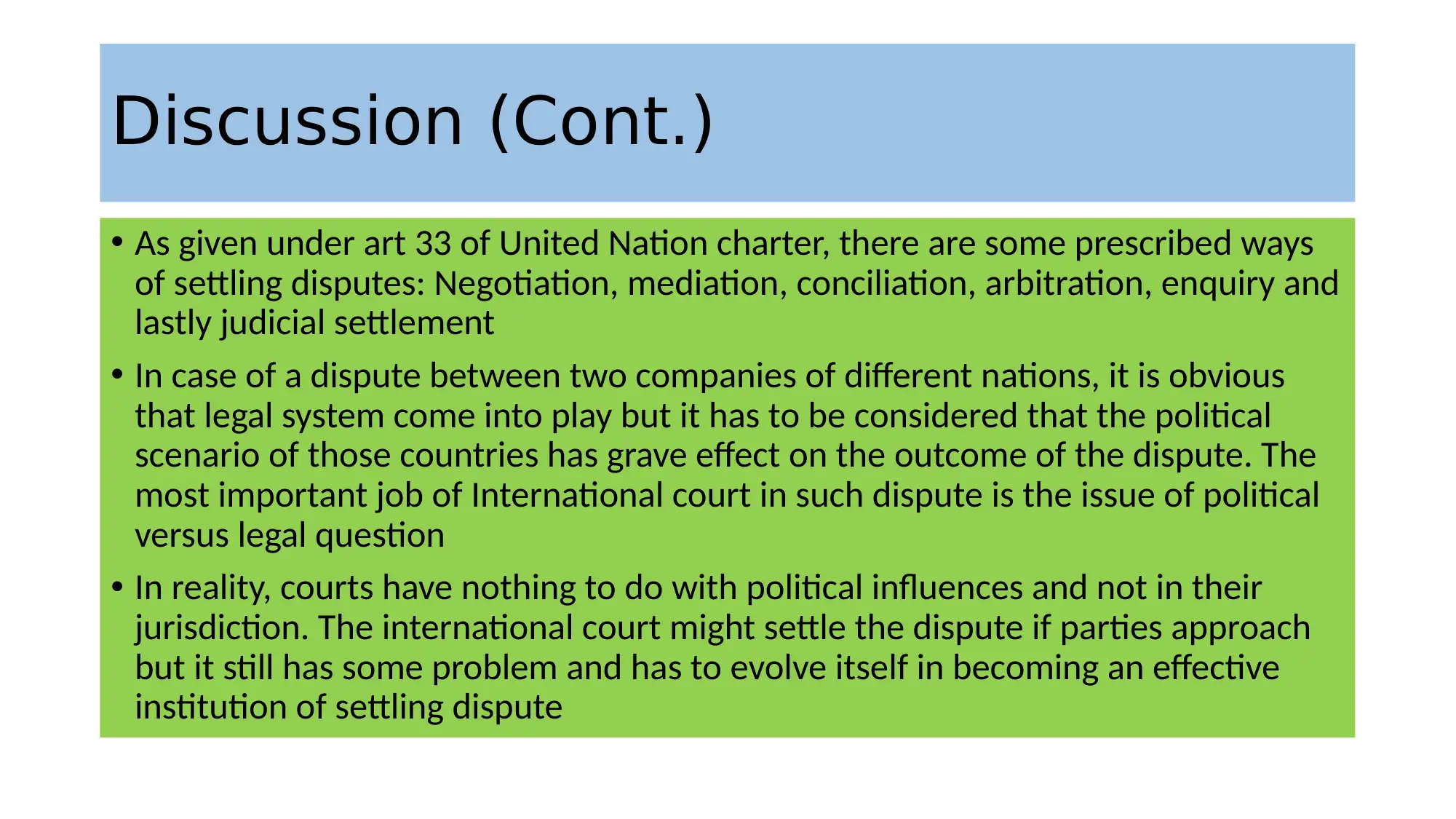
Discussion (Cont.)
• As given under art 33 of United Nation charter, there are some prescribed ways
of settling disputes: Negotiation, mediation, conciliation, arbitration, enquiry and
lastly judicial settlement
• In case of a dispute between two companies of different nations, it is obvious
that legal system come into play but it has to be considered that the political
scenario of those countries has grave effect on the outcome of the dispute. The
most important job of International court in such dispute is the issue of political
versus legal question
• In reality, courts have nothing to do with political influences and not in their
jurisdiction. The international court might settle the dispute if parties approach
but it still has some problem and has to evolve itself in becoming an effective
institution of settling dispute
• As given under art 33 of United Nation charter, there are some prescribed ways
of settling disputes: Negotiation, mediation, conciliation, arbitration, enquiry and
lastly judicial settlement
• In case of a dispute between two companies of different nations, it is obvious
that legal system come into play but it has to be considered that the political
scenario of those countries has grave effect on the outcome of the dispute. The
most important job of International court in such dispute is the issue of political
versus legal question
• In reality, courts have nothing to do with political influences and not in their
jurisdiction. The international court might settle the dispute if parties approach
but it still has some problem and has to evolve itself in becoming an effective
institution of settling dispute
Paraphrase This Document
Need a fresh take? Get an instant paraphrase of this document with our AI Paraphraser
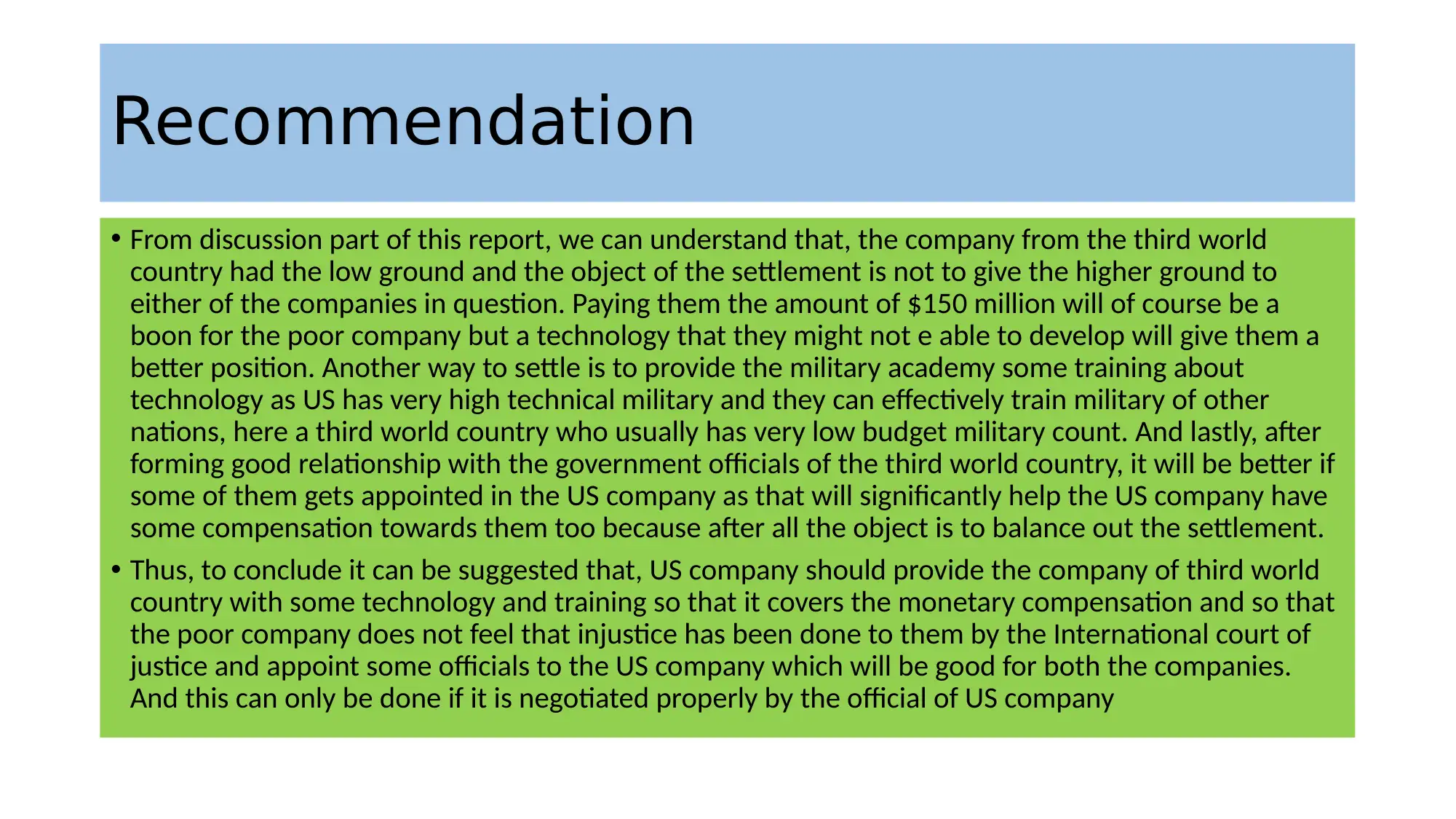
Recommendation
• From discussion part of this report, we can understand that, the company from the third world
country had the low ground and the object of the settlement is not to give the higher ground to
either of the companies in question. Paying them the amount of $150 million will of course be a
boon for the poor company but a technology that they might not e able to develop will give them a
better position. Another way to settle is to provide the military academy some training about
technology as US has very high technical military and they can effectively train military of other
nations, here a third world country who usually has very low budget military count. And lastly, after
forming good relationship with the government officials of the third world country, it will be better if
some of them gets appointed in the US company as that will significantly help the US company have
some compensation towards them too because after all the object is to balance out the settlement.
• Thus, to conclude it can be suggested that, US company should provide the company of third world
country with some technology and training so that it covers the monetary compensation and so that
the poor company does not feel that injustice has been done to them by the International court of
justice and appoint some officials to the US company which will be good for both the companies.
And this can only be done if it is negotiated properly by the official of US company
• From discussion part of this report, we can understand that, the company from the third world
country had the low ground and the object of the settlement is not to give the higher ground to
either of the companies in question. Paying them the amount of $150 million will of course be a
boon for the poor company but a technology that they might not e able to develop will give them a
better position. Another way to settle is to provide the military academy some training about
technology as US has very high technical military and they can effectively train military of other
nations, here a third world country who usually has very low budget military count. And lastly, after
forming good relationship with the government officials of the third world country, it will be better if
some of them gets appointed in the US company as that will significantly help the US company have
some compensation towards them too because after all the object is to balance out the settlement.
• Thus, to conclude it can be suggested that, US company should provide the company of third world
country with some technology and training so that it covers the monetary compensation and so that
the poor company does not feel that injustice has been done to them by the International court of
justice and appoint some officials to the US company which will be good for both the companies.
And this can only be done if it is negotiated properly by the official of US company
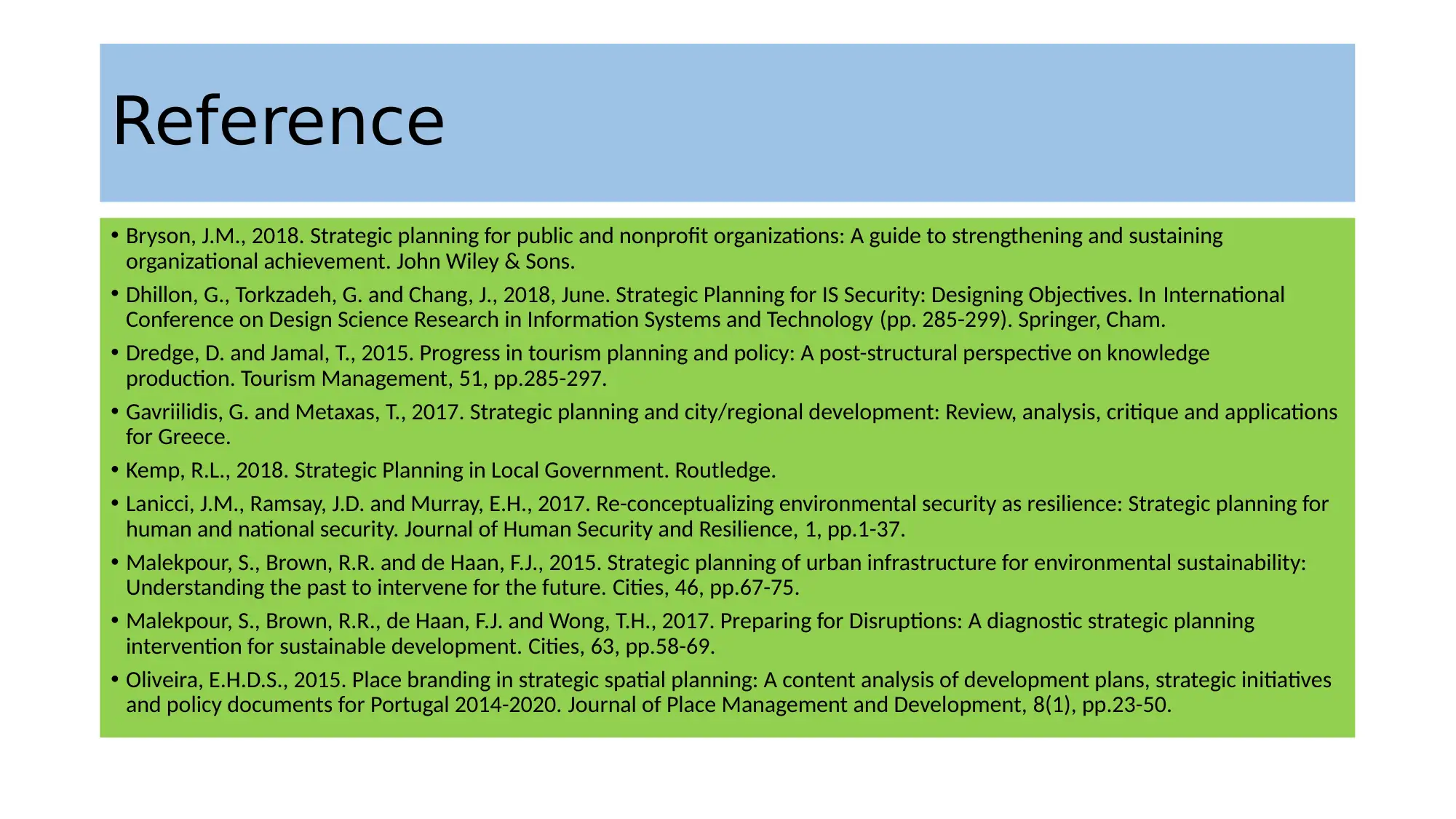
Reference
• Bryson, J.M., 2018. Strategic planning for public and nonprofit organizations: A guide to strengthening and sustaining
organizational achievement. John Wiley & Sons.
• Dhillon, G., Torkzadeh, G. and Chang, J., 2018, June. Strategic Planning for IS Security: Designing Objectives. In International
Conference on Design Science Research in Information Systems and Technology (pp. 285-299). Springer, Cham.
• Dredge, D. and Jamal, T., 2015. Progress in tourism planning and policy: A post-structural perspective on knowledge
production. Tourism Management, 51, pp.285-297.
• Gavriilidis, G. and Metaxas, T., 2017. Strategic planning and city/regional development: Review, analysis, critique and applications
for Greece.
• Kemp, R.L., 2018. Strategic Planning in Local Government. Routledge.
• Lanicci, J.M., Ramsay, J.D. and Murray, E.H., 2017. Re-conceptualizing environmental security as resilience: Strategic planning for
human and national security. Journal of Human Security and Resilience, 1, pp.1-37.
• Malekpour, S., Brown, R.R. and de Haan, F.J., 2015. Strategic planning of urban infrastructure for environmental sustainability:
Understanding the past to intervene for the future. Cities, 46, pp.67-75.
• Malekpour, S., Brown, R.R., de Haan, F.J. and Wong, T.H., 2017. Preparing for Disruptions: A diagnostic strategic planning
intervention for sustainable development. Cities, 63, pp.58-69.
• Oliveira, E.H.D.S., 2015. Place branding in strategic spatial planning: A content analysis of development plans, strategic initiatives
and policy documents for Portugal 2014-2020. Journal of Place Management and Development, 8(1), pp.23-50.
• Bryson, J.M., 2018. Strategic planning for public and nonprofit organizations: A guide to strengthening and sustaining
organizational achievement. John Wiley & Sons.
• Dhillon, G., Torkzadeh, G. and Chang, J., 2018, June. Strategic Planning for IS Security: Designing Objectives. In International
Conference on Design Science Research in Information Systems and Technology (pp. 285-299). Springer, Cham.
• Dredge, D. and Jamal, T., 2015. Progress in tourism planning and policy: A post-structural perspective on knowledge
production. Tourism Management, 51, pp.285-297.
• Gavriilidis, G. and Metaxas, T., 2017. Strategic planning and city/regional development: Review, analysis, critique and applications
for Greece.
• Kemp, R.L., 2018. Strategic Planning in Local Government. Routledge.
• Lanicci, J.M., Ramsay, J.D. and Murray, E.H., 2017. Re-conceptualizing environmental security as resilience: Strategic planning for
human and national security. Journal of Human Security and Resilience, 1, pp.1-37.
• Malekpour, S., Brown, R.R. and de Haan, F.J., 2015. Strategic planning of urban infrastructure for environmental sustainability:
Understanding the past to intervene for the future. Cities, 46, pp.67-75.
• Malekpour, S., Brown, R.R., de Haan, F.J. and Wong, T.H., 2017. Preparing for Disruptions: A diagnostic strategic planning
intervention for sustainable development. Cities, 63, pp.58-69.
• Oliveira, E.H.D.S., 2015. Place branding in strategic spatial planning: A content analysis of development plans, strategic initiatives
and policy documents for Portugal 2014-2020. Journal of Place Management and Development, 8(1), pp.23-50.
⊘ This is a preview!⊘
Do you want full access?
Subscribe today to unlock all pages.

Trusted by 1+ million students worldwide
1 out of 6
Related Documents
Your All-in-One AI-Powered Toolkit for Academic Success.
+13062052269
info@desklib.com
Available 24*7 on WhatsApp / Email
![[object Object]](/_next/static/media/star-bottom.7253800d.svg)
Unlock your academic potential
Copyright © 2020–2025 A2Z Services. All Rights Reserved. Developed and managed by ZUCOL.





